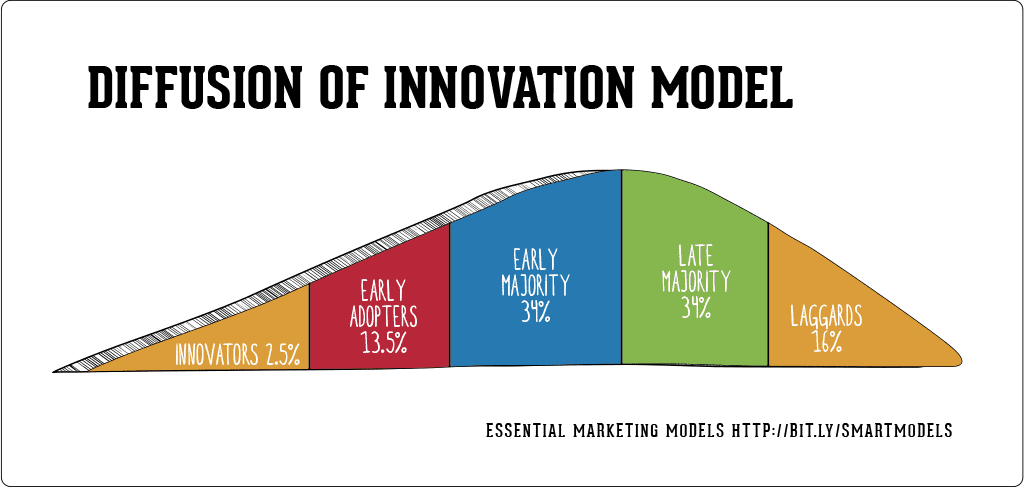Today, I will be discussing Roger's Diffusion of Innovations. Essentially, it's a bell curve that shows how new innovations or ideas catch on in the public eye.
Just thinking about the bell curve in terms of a new innovation, there are few people who buy the new product right when it comes out. These people are called Pioneers/Innovators, and they're the ones who take a leap of faith and are the first ones to try the new product out when it's still in an experimental phase.
Next, there are Early Adopters who seep into the Early Majority. This is the time when the new product really starts to take-off, and a huge second wave of people start to catch on to the new product.
Then, the product reaches the Tipping Point, and this is when the majority of people have this new product. This is right in the middle of the bell curve.
After, there are Late Adopters who are just as they sound... late to the game. They might have thought that they didn't need the new product, so they held off from buying. Then, after seeing their neighbor with the new product, they eventually decide to get it. At this point, the new product has reached saturation within the public.
Even further after, there are the Laggards. Now, the product has reached maturation, but there are still some people who don't have the product. It's important to note that the tail of the bell curve can be very long, but it never reaches zero. This is because of the multiple barriers to entry; moreover, people might not be able to afford it, or they might be unable to for geographical reasons.
Therein lies Roger's Diffusion of Innovations bell curve. Below is a visual to help really understand this theory.
Just thinking about the bell curve in terms of a new innovation, there are few people who buy the new product right when it comes out. These people are called Pioneers/Innovators, and they're the ones who take a leap of faith and are the first ones to try the new product out when it's still in an experimental phase.
Next, there are Early Adopters who seep into the Early Majority. This is the time when the new product really starts to take-off, and a huge second wave of people start to catch on to the new product.
Then, the product reaches the Tipping Point, and this is when the majority of people have this new product. This is right in the middle of the bell curve.
After, there are Late Adopters who are just as they sound... late to the game. They might have thought that they didn't need the new product, so they held off from buying. Then, after seeing their neighbor with the new product, they eventually decide to get it. At this point, the new product has reached saturation within the public.
Even further after, there are the Laggards. Now, the product has reached maturation, but there are still some people who don't have the product. It's important to note that the tail of the bell curve can be very long, but it never reaches zero. This is because of the multiple barriers to entry; moreover, people might not be able to afford it, or they might be unable to for geographical reasons.
Therein lies Roger's Diffusion of Innovations bell curve. Below is a visual to help really understand this theory.
 |
| Diffusion of Innovation Model visual found online.
Time to apply this theory to a recent innovation/idea, and I am going to apply this to the app, TikTok.
TikTok was first launched in September 2017, and its early adopters were basically all middle school kids. For the first couple months, the vast majority of people using TikTok were in the 11-16 age range. These youngin's were the pioneers!!
Then, over the next two months, all of the early adopters and early majority started to catch on to the new, young trend. TikTok was the #1 most downloaded free mobile app by January 2018. It only tool TikTok four months to reach its Tipping Point.
However, because the first half of TikTok's bell curve was so quick, the second half has been much longer. In my opinion, this is due to Viral Marketing which is a recent trend on social media which causes a new innovation to reach its peak faster.
That being said, I believe that almost two years after hitting their Tipping Point, TikTok is still in the Late Majority phase of their bell curve.
For example, I just downloaded TikTok last week, and I think I would be the minority of people in this class, for example, who have the app downloaded. The app is just starting to be used by college aged kids as the younger generations start to enter their freshman year. This is having some influence of the rest of us, who are downloading the app as the late majority.
TikTok will still be in this Late Majority section for a couple more months at least, in my opinion. Eventually, more and more people will download it, and the app will reach maturation. But again, I don't see that happening for awhile.
I think TikTok is a cool and interesting example because the innovators/pioneers were the youngest kids, and the older generations have followed their leads. This is sort of unconventional but shows how technology is giving younger kids endless possibilities.
I hope that young kids continue to be innovators and pioneers, and they grow up to create the next new app sensation.
|
Comments
Post a Comment